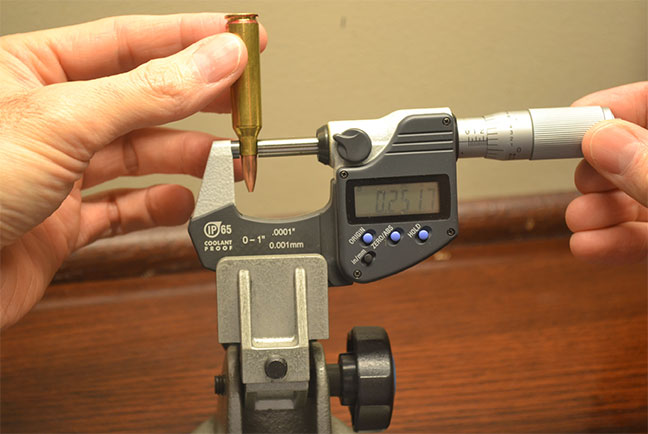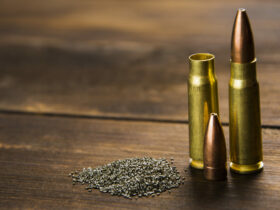When I was young and new to varmint hunting, I was lucky to fall in with an older, more experienced group. The oldest, and the leader of the group, took me under his wing and mentored me. This casually thrown together small group of friends called themselves Predators Unlimited. From their home base in the greater Los Angeles area, they hunted over much of the western United States.
As it happened, their passions for varmint hunting made the pursuit of accurate rifles a passion. Those not old enough should know that in the late ’60s early ’70s accurate rifles and ammunition was a highly-prized commodity. They didn’t know all they do today about what makes rifles and ammo accurate, and much experimentation was taking place.

Back then, if a sporting rifle held 3 inches at 100 yards it was considered good, and only benchrest rifles inhabited the terrain of an inch or so. To hunt with my new friends, I had to prove I could shoot the magic inch or so. Off to the range we went, so I could audition for them.
Through good conditions and luck, I was acceptable. However, I needed some help and so the mentoring began. One of the first things my mentor, asked was if I full length or neck resized my cases. Of course, I did not neck size. He then preceded to introduce me to the ways of neck resizing the way the benchrest shooters of the day were doing it.
That was how I was introduced to neck resizing, and I have been doing so ever since. Today, we know a lot more about what makes accurate, precise rifles and ammunition than we knew then. However, I still believe neck sizing has its place. Let’s examine some of the pros and cons, so you can decide if it’s for you.
Why Neck Resizing
When a cartridge is fired, it briefly expands to seal the entire chamber and prevent any gas or powder from escaping the action and causing injury. When the bullet leaves the barrel, the pressure generated by the burning powder drops, and the case contracts enough to allow it to be extracted from the chamber. It’s in the neck of the case that the expansion is most notable, because it must stretch to a width that will no longer grip a bullet when it comes time to reuse the case.
The brass for cartridges is a type of brass alloy that is referred to as “70-30 Cartridge Brass” which is basically 70% copper and 30% zinc. The combination provides the strength and ductility to expand and contract while restraining the forces being generated. A full-length sizing die squeezes the entire piece of brass back into its smaller, specified size for the specific caliber as opposed to a neck-sizing die that only reshapes the neck enough to grasp the bullet.

When you neck size only, you gain the benefits of fire forming, the most important of which is in increased accuracy. The reason for that is when your brass is fired, it expands to fit your chamber. When you extract that fired piece of brass from your bolt-action, you will have a case that is fire formed to match your specific guns chamber. Full-length sizing literally erases that “custom fit” whereas neck sizing leaves your case’s body custom fitted to your firearm.
As an experiment, the next time you are at the range, take a freshly-fired case from the rifle and re-insert it into the same bolt-action rifle’s chamber. Not only will it fit, but it should be an exact fit because it was fire formed in the shape of that rifle’s chamber. If you wanted to reload and fire the case again (from the same rifle), all you have to do is clean it up, and reduce the diameter of the neck enough for it to hold a bullet securely. You would leave the rest of the case in ‘as-is’ condition because it has been fire formed to that chamber. That is how neck sizing works.
Important Consideration
You absolutely cannot use neck-sized ammo in any firearm other than the rifle that it was fired in. If you have several rifles of the same caliber — as I do — take care to keep all ammo clearly marked as to which rifle it was reloaded for and that it was neck sized only. Store it separately from other cartridges of the same caliber that are full length or neck sized for a different rifle.
It is appropriate to neck size cartridges for a bolt-action or single-shot rifles only. Remember, the case has been fire-formed to a specific chamber and as such, a neck sized cartridge can only be used in the rifle that fired it. If plan on shooting the ammo in another rifle, you absolutely have to full-length size it.

Caveat! Understand that neck resizing should only be considered for ammunition that will be used in the same rifle that it was fired in. Cartridges for semi-auto, lever-action, or slide-action rifles should never be neck sized. The cartridge will be too tight to reliably feed from the magazine, up the feed ramp, and into the chamber.
This is so important that I will say it again…
Neck sizing should never be employed for ammunition intended to be used with autoloading rifles. With a bolt-action, the custom-fitted round is eased into the chamber at a much slower velocity than that experienced with an autoloader. Experts warn that the force from a high-speed bolt hitting a fire-formed round may result in a slam fire because of the brass’ tight fit into the chamber. So remember, cartridges for semi-auto and full-auto rifles should be full-length sized only.
Additional Advantages
An additional advantage in favor of neck sizing includes longer brass life, so you can get more reloads before your brass needs to be discarded. There are fewer reloading steps when you neck size, and the brass stretches less. Therefore, you don’t have to trim as much, and because very little case stretching occurs the case walls do not thin out.
Additionally, it is not necessary to lube the cases prior to resizing them, or to removing the lube after sizing. This potentially eliminates two reloading steps. When neck sizing, you’re only sizing the neck and that requires very little pressure to operate the press. So little in fact that you will not realize that you have sized the cases at all. And that is with no lube.
Know the Limits
There is a practical limit for neck-sized cases. Depending on how hot you load your cartridges, I recommend that after about 5 reloads, the cases will have expanded enough to begin making chambering difficult. When that happens, you should full-length resize the cases, measure them, trim as necessary and start the process over again.

You must also be aware of a few requirements of neck sizing that goes beyond limiting your rounds to a single firearm and extending your choice of brass. Because different makes of brass have different wall thicknesses, your process will be affected. Any variation within the brass thickness of the case affects concentricity and the bullet seating angle. Of all these factors, the bullet seating angle probably contributes the most to non-concentricity — especially if you’re not using a competition seating die. Take ‘extra’ care when seating the bullet. Experiment with different brands of brass to see which brand works best for you.
A possible negative result may be that you find that your neck-sized ammo produces larger groups than identically loaded full-length sized ammo. If this is the case, it is likely caused by something being non-concentric. Even a carefully machined chamber and barrel will have some barely measurable non-concentricity. Some rifles are much worse than others.
Keep in mind that a full-length, sized cartridge has a slightly looser fit in the chamber than a neck-sized cartridge. This extra clearance exists everywhere except for the fit between the outside diameter of the bullet and the inside diameter of the neck. By having clearance everywhere else on the cartridge, the bullet entering the neck can self-center. This acts as a pilot to align the rest of the cartridge with the center of the bore.

With a neck-sized cartridge, little clearance exists between the case and chamber. This minimizes the ability of the bullet to center itself in the neck. If enough non-concentricity exists, the bullet can be shoved hard against one side of the neck when the cartridge is chambered, resulting in reduced accuracy.
A trick I was taught many years ago is to slowly seat the bullet. As you do, release pressure, lower it a bit, and turn it slightly. You keep repeating that until the bullet is seated. In that way, if it is going in at an angle, by turning it you slowly correct the angle for a more concentric fit. This is just an introduction to the basics of neck sizing. I have been doing it for my precision rifles for 50 years and believe my shooting has benefited greatly. If you appreciate accurate, precise rifles try it. I think you will like it.
What is your experience with neck resizing cartridges? Share your thoughts in the Comment section.
Source link: https://blog.cheaperthandirt.com/cartridges-neck-resizing-vs-full-length-resizing/?utm_source=rss&utm_medium=rss&utm_campaign=cartridges-neck-resizing-vs-full-length-resizing by Ed AKA “The Real Most Interesting Man in The World” LaPorta at blog.cheaperthandirt.com








